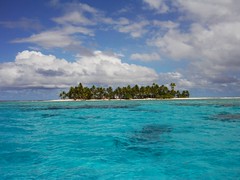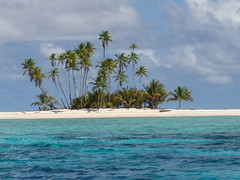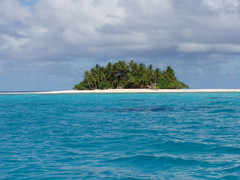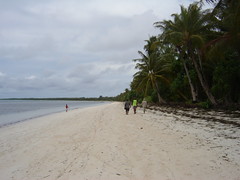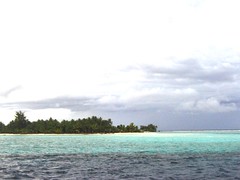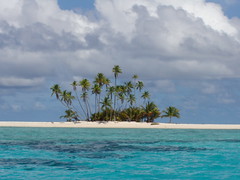
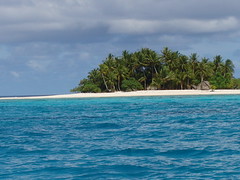
The total land area is only a minute 12 sq km with the widest stretch of dry ground on the islands of Luaniua (population 1300) and Pelau (400 people) measuring only one km, while the average breadth of many of its islands is only a third of this. No island is higher than 13m above sea level with most islands barely one to three meters high and composed mostly of coral debris.
Apart from the two main villages of Luaniua and Pelau, few other islands have temporary shelters where a small number of about 50 people now live almost permanently, and where there are fine beaches, good coral and plenty of fish throughout the lagoon. The two populated islands consist of freshwater swamps where natural depressions have been artificially deepened for mulching pits to cultivate taro crops, a staple diet on the atoll.
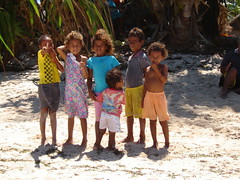
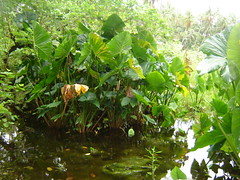
Coastal areas consist of narrow strips of coconut palms and scrub, mainly on the ocean side. Annual consumption of coconuts by the atoll's inhabitants is estimated to be around 600000 nuts annually which averages about one coconut per person per day.
Besides collecting beche-de-mer and trochus shells for the Hong Kong market, the people of Ontong Java often exchange with copra for goods at the only two small stores on Luaniua and Pelau. Houses are built flush to the ground with a network of poles forming the frame with the roof thatched with pandanus leaves.
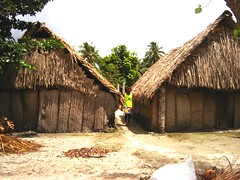
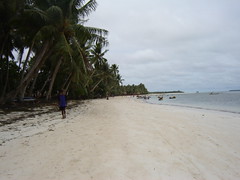
Pottery dating back 2000 years has been discovered on the atoll and studies into the atolls language suggest it is related to both the Samoan and Tongan tongues. Believed to have separated from its mother tongue, their language passed in about 300 AD through Tokelau or Tuvalu before reaching the atoll from there.
In 1616 Dutch adventurers Le Marie and Schouten may have sighted Pelau and its adjacent islets. But it was Abel Tasman who in March 1643 first sighted the atoll, and believing his sighting was the precursor of good fortune called the group Ontong Java.
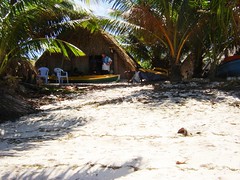
Later in 1791, John Hunter became the first European to set foot on the atoll's soil and renamed it Lord Howe Atoll. Whalers and traders later followed and in the 1870s black birders in search of slaves began visiting the group.
IN 1893 Germany annexed the atoll but later ceded it to Britain in 1899.
Sea birds are prolific on Ontong Java, and some islanders keep frigate birds as free-flying pets. The black-naped tern is plentiful and is believed to breed only on this atoll. This medium-sized nearly all-white sea bird has a black line running from its eyes to the nape of its neck.
Megapode birds are plentiful and lay their eggs in self-built mulch mounds. Because of the people's traditional association with the megapode bird, they have flourished as the birds and their eggs are not eaten.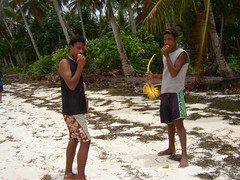
Ontong Java art consist of gaunt geometrically shaped female deity figures, which were a distinctive feature of the atoll's statue art. The lower part of the face was portrayed as an inverted triangle with straight lines to represent the eyebrows and nose. Some of these still exist. Graveposts are made from wood and coral rock and stylised with human faces.
Pearl shells are shaped to make fish-hooks, necklaces and nasal pendants and women use back-loom for weaving. Loincloths made on a loom are then dyed with tumeric.
In society and conduct, the Ontong Java people observe traditional customs in relation to marriage and property. The male line owns the coconut groves and does the fishing, while the female side maintains the taro plots and is prominent domestically.
Many men and women in Ontong Java are tattooed with the forehead decorated with marine or geometrical designs in childhood, which are later extended to other parts of the body. Some tattoo designs are in the shape of a hook used for catching oil fish which is local delicacy.
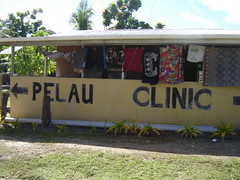
Yachts and ships can use one of the 23 passages through the reef to enter the atoll. To the south is Ke Avaiko Passage leading to the main anchorage at Luaniua.
Photos and Story by Rex Tara, 2006.
